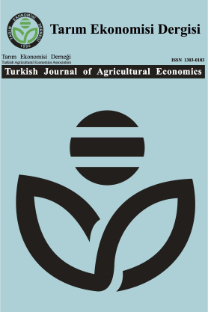Tarım İşletmelerinin Toplam Ekonomik Performansının Ölçülmesi: Burkina Faso’dan Örnek Bir Çalışma
Toplam Ekonomik Performans Göstergesi, Tarım İşletmeciliği, Mısır, Burkina Faso
Conceptual Framework for Measuring the Overall Economic Performance of Farms: A Case Study from Burkina Faso
___
- Bouljlida A. 2002. La performance financière des PME manufacturières : Conceptualisation et mesure. Mémoire présenté à Université du Québec à Trois-Rivières
- Bouquin H., 1986. Le contrôle de gestion, Presses Universitaires de France, Paris
- Bourguignon A., 1997. Sous les pavés la plage...ou les multiples fonctions du vocabulaire comptable : l'exemple de la performance, Comptabilité Contrôle Audit, 1(3): 89-101.
- Bremmers, H., Omta, O., Kemp, R., and Haverkamp, D-J. 2007. Do Stakeholder Groups Influence Environmental Management System Development in the Dutch Agri-Food Sector? Business Strategy and the Environment Bus. Strat. Env. 16: 214–231,
- Crapon M., and Quairel-Lanoizelée F. 2005. Mythes et réalités de l'entreprise responsable, Paris, Ed. La Découverte.
- De Rochambeau, H., Veronese, T., and Roché, P. 2008. Un exemple d'écoconception dans les filières agricoles, agroalimentaires et agro-industrielles : le pôle de compétitivité « AgriMip Innovation » en région Midi-Pyrénées. Annales des Mines - Réalités industrielles, pp. 72-77.
- Delen, D., Kuzey,C., and Uyar, A. 2013. Measuring firm performance using financial ratios: A decision tree approach. Expert Systems with Applications 40(10) 3970–3983.
- Dohou, A., and Berland, N. 2008. Mesure de la performance globale des entreprises, Communication au congrès annuel de l'Association Francophone de Comptabilité, Poitiers, 22 p.
- Kalogeras ,N., Baourakis, G., Zopounidis,C., and Dijk van, G. 2005. Journal of Food Engineering 70: 365–371
- Kasterine, A., and Vanzetti, D. 2010. The Effectiveness, Efficiency and Equity of Market Based and Voluntary Measures to Mitigate Greenhouse Gas Emissions from the Agri-Food Sector. UNCTAD Trade and Environment Review, 37 p
- Kroma, S., and Lamien N. 2017. Evaluation de la rentabilité et de la compétitivité de la chaine de valeur gomme arabique dans l’amélioration des conditions de vie des populations au sahel du Burkina Faso. Agronomie Africaine Sp. 29(1): 29 - 40.
- Latruffe, L. 2010. Competitiveness, Productivity and Efficiency in the Agricultural and Agri-Food Sectors. OECD Food, Agriculture and Fisheries Working Papers, No. 30, OECD Publishing. http://dx.doi.org/10.1787/5km91nkdt6d6-en (Available December 20, 2018).
- Maxime, D., Marcotte, M., and Arcand, Y. 2005. Development of eco-efficiency indicators for the Canadian food and beverage industry. Journal of Cleaner Production 14 : 636-648Morin, E. M. 2001. Dimensions, critères et indicateurs de performance.
- Naro, 2005. Responsabilité sociale de l’entreprise et pilotage des performances, Chapitre 4 in : La responsabilité sociale de l’entreprise, Dir. F. Le Roy et M. Marchesnay, Ed. EMS Management et Société, pp. 59-71.
- Rastoin, J.-L. 2006. Vers de nouveaux modèles d’organisation du système agroalimentaire ? Approches stratégiques. MSH-M Séminaire de recherche Produits de terroir, filière qualité et développement Montpellier, (22 juin 2006)
- Zahm, F., Alonso A., and Ugaglia, B. De l’Homme. L’évaluation de la performance globale d’une exploitation agricole. Synthèse des cadres conceptuels, des outils de mesure et application avec la méthode IDEA. 8`eme Congrès du RIODD, Jun 2013, Lille, France. 32 p., 2013. (Available December 20, 2018).
- ISSN: 1303-0183
- Yayın Aralığı: Yılda 2 Sayı
- Başlangıç: 1992
- Yayıncı: Tarım Ekonomisi Dergisi
Zeki BAYRAMOĞLU, Orhan GÜNDÜZ, Zuhal KARAKAYACI, Yusuf ÇELİK
Tarım İşletmelernn Toplam Ekonomk Performansının Ölçülmes: Burkna Faso'dan Örnek Br Çalışma
Tarım Sektöründe Arge ve İnovasyon
Gıda ve İçecek Tüketmnde Yen Trendlern Değerlendrlmes
Overall Economic Performance of Farms in Burkina Faso: Case of Maize
Türkiye'de Coğrafi İşaretli Gıda Ürünlerinin Gurme Turizmi Açısından Önemi
Bilal BİLGE, Nevin DEMİRBAŞ, Metin ARTUKOĞLU
Türkiye Turunçgiller İhracatının Rekabet Gücünün Analizi
Plastik Serada SivrBiber Üretiminin Teknik Etkinliği: Mersin İli Örneği, Türkiye
Türkiye'de Gelirin Gıda Tüketimi Üzerine Etkisi
Alper DEMİRDÖĞEN, Emine OLHAN, Gökhan AYKAÇ
Emre TORGUT, Serdar ANNAYEV, Mürşide Çağla ÖRMECİ KART, Berna TÜRKEKUL
